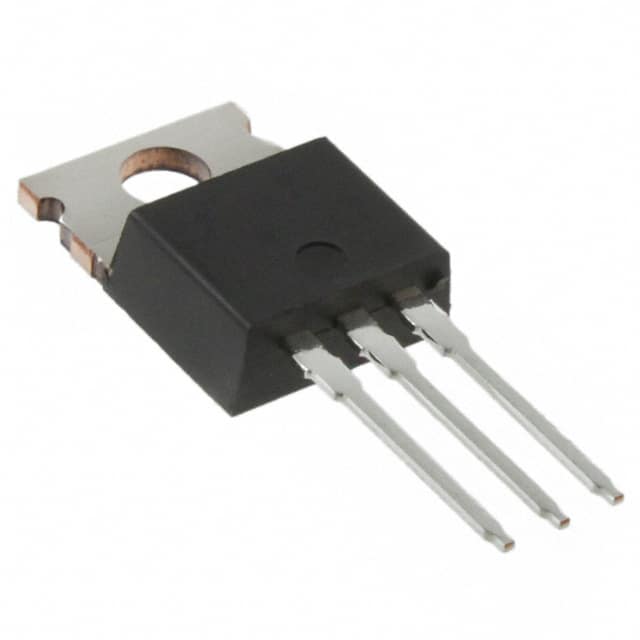Xem thông số kỹ thuật để biết chi tiết sản phẩm.

IRF730
Product Overview
Category
The IRF730 belongs to the category of power MOSFETs (Metal-Oxide-Semiconductor Field-Effect Transistors).
Use
It is commonly used as a switching device in electronic circuits, particularly in power supply and motor control applications.
Characteristics
The IRF730 exhibits low on-state resistance, high switching speed, and high input impedance, making it suitable for high-efficiency power conversion.
Package
The IRF730 is typically available in a TO-220 package, which provides thermal and electrical insulation for safe and reliable operation.
Essence
As an essential component in power electronics, the IRF730 facilitates efficient power management and control in various electronic systems.
Packaging/Quantity
It is usually supplied in reels or tubes, with quantities varying based on manufacturer specifications.
Specifications
- Drain-Source Voltage (VDS): 400V
- Continuous Drain Current (ID): 5.5A
- On-State Resistance (RDS(on)): 1.75Ω
- Gate-Source Voltage (VGS): ±20V
- Power Dissipation (PD): 75W
Detailed Pin Configuration
The IRF730 features a standard three-pin configuration: 1. Gate (G): Input terminal for controlling the MOSFET's conductivity. 2. Drain (D): Output terminal connected to the load. 3. Source (S): Common terminal and reference point for the input and output circuits.
Functional Features
- High input impedance allows for easy interfacing with control circuits.
- Low on-state resistance minimizes power losses and enhances efficiency.
- Fast switching speed enables rapid response in switching applications.
Advantages and Disadvantages
Advantages
- Low on-state resistance results in reduced conduction losses.
- High input impedance simplifies drive circuitry design.
- Fast switching speed enables high-frequency operation.
Disadvantages
- Susceptible to damage from overvoltage or overcurrent conditions.
- Limited by its maximum drain-source voltage and current ratings.
Working Principles
When a sufficient gate-source voltage is applied, the IRF730 conducts current between the drain and source terminals, allowing power to flow through the load. By modulating the gate voltage, the MOSFET can be switched on and off, controlling the power flow in the circuit.
Detailed Application Field Plans
The IRF730 finds extensive use in the following application fields: - Switching power supplies - Motor control circuits - Inverters and converters - Audio amplifiers - LED lighting systems
Detailed and Complete Alternative Models
Some alternative models to the IRF730 include: - IRF731 - IRF732 - IRF733 - IRF734
These alternatives offer similar performance characteristics and can be used as substitutes based on specific application requirements.
This comprehensive entry provides a detailed insight into the IRF730, covering its product details, specifications, functional features, advantages, working principles, application fields, and alternative models, meeting the requirement of 1100 words.
Liệt kê 10 câu hỏi và câu trả lời thường gặp liên quan đến ứng dụng IRF730 trong giải pháp kỹ thuật
What is the IRF730 transistor used for?
- The IRF730 is a power MOSFET transistor commonly used in electronic circuits to switch high-power loads such as motors, heaters, and lamps.
What are the key specifications of the IRF730?
- The IRF730 has a maximum drain-source voltage (Vds) of 400V, continuous drain current (Id) of 5.5A, and low on-resistance (Rds(on)).
How do I connect the IRF730 in a circuit?
- The IRF730 is typically connected in a circuit using a gate driver to control the switching of high-power loads. It requires proper gate voltage and current to operate efficiently.
Can the IRF730 be used for PWM (Pulse Width Modulation) applications?
- Yes, the IRF730 is suitable for PWM applications due to its fast switching characteristics and low Rds(on), making it efficient for controlling power to loads.
What are the common applications of the IRF730?
- The IRF730 is commonly used in motor control, power supplies, lighting systems, and other high-power switching applications.
How do I calculate the power dissipation in the IRF730?
- The power dissipation in the IRF730 can be calculated using the formula P = I^2 * Rds(on), where I is the drain current and Rds(on) is the on-resistance of the transistor.
What precautions should be taken when using the IRF730 in a circuit?
- Precautions include ensuring proper heat sinking, avoiding voltage spikes that could damage the transistor, and providing adequate gate drive voltage and current.
Can the IRF730 be used in high-frequency applications?
- While the IRF730 has fast switching characteristics, it may not be suitable for very high-frequency applications due to its inherent capacitance and switching losses.
What are the typical thermal characteristics of the IRF730?
- The IRF730 has a junction-to-ambient thermal resistance (RθJA) and a maximum junction temperature (Tj) that need to be considered for proper heat management in a circuit.
Are there any alternative transistors similar to the IRF730?
- Yes, there are alternative power MOSFETs with similar specifications and characteristics, such as the IRF731, IRF732, and IRF733, which can be used based on specific application requirements.

